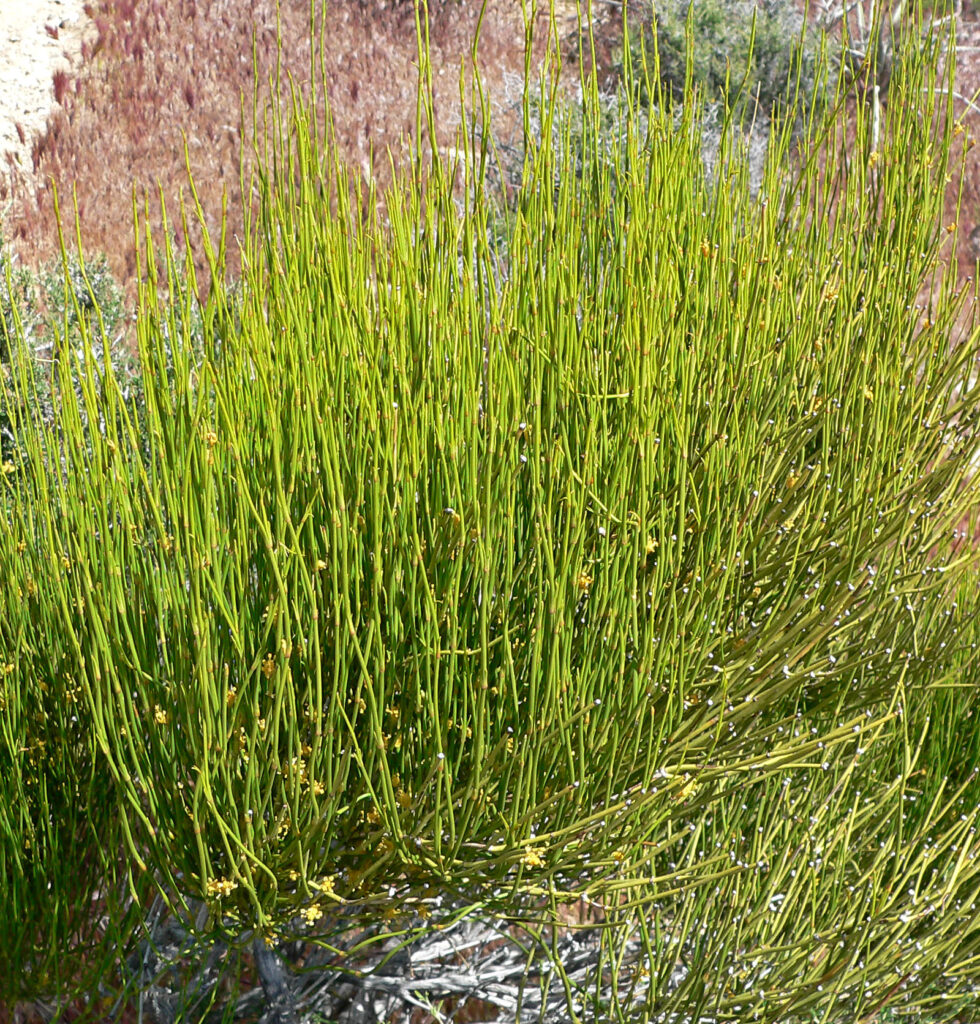Drug Wars In Nature: The Ephedra Gang

Ephedra virdis, photo by Stan Shebs, Wikipedia.
In the arid American West, there resides a genus of bushes, which by Midwestern standards appear hardly alive. The half-dozen members of the genus Ephedra are called jointfirs and look like clusters of skinny sticks, sorta green in the wet season and more brown or gray most of the year. Only upon close inspection do you notice that the little scales clasping the sticks are actually tiny leaves. This is part of their defense against dry air, dry soils, and hungry grazers who don’t find much to eat in a land full of thorns and needles.
The ephedra have not gone the thorny route of cacti and ocotillo, but rather like many plant species worldwide, have bolstered their defenses with a package of aggressive alkaloids. These include ephedrine, pseudoephedrine, methylephedrine, norpseudoephedrine and norephedrine, each species harboring a somewhat different mix, probably tailored to a different group of predators. For more on the desert jointfirs, I recommend William Cullina’s “Native Trees Shrubs and Vines,” Houghton Mifflin.
For creatures, including us, these molecules are stimulants, meaning that they speed up the messaging system around the body. The effects include a rapid heartbeat, greater muscle strength, more acuity, weight loss and a reduced sense of fatigue, all marketable attributes to athletes, soldiers, and citizens depressingly slogging through their daily lives.
An Asian jointfir called ma huang has been used by Chinese herbalists for millennia to provide these stimulants, and in recent decades, Mormon tea, one of the American ephedra species, has been used the same way. Their popularity waxes and wanes because it is easy to get addicted and overdose, leading to seizures, stroke and death. This is how the jointfirs protect themselves from overgrazing. They are a tough gang.
In the more controlled pharmaceutical market, pseudoepedrine and ephedrine had long been used as a decongestant and bronchodilator, improving breathing for people with asthma and other lung issues. In searching for patentable equivalent drugs, the pharmaceutical industry came up with amphetamine and methamphetamine.
In WWII, both the Allied and Axis powers provided large quantities of amphetamines to soldiers and pilots for enhanced performance. German and Japanese troops were also issued methamphetamine. This was the beginning of an epidemic following the war, in which doctors routinely prescribed both drugs to people who wanted to feel better and seem more youthful as they aged. For example, it appears that President John F. Kennedy was prescribed methamphetamines to cope with the job and maintain his youthful demeanor. It took decades to gradually retrain doctors and regulate this “legal” trade.
The second epidemic got underway when backyard chemists found that they could cook up a variety of molecules with similar “upper” properties, using legal pseudoephedrine (“Sudafed”) as a starting point. For example, most of that molecular family has a high melting point, having evolved in hot desserts, which does not lend itself to getting high on the smoke. With some simple chemistry, the meth-cookers came up with a low melting point crystalline version, which can be smoked and inhaled, appropriately labeled “ice” or “crystal.” Attempting to counteract this, the U.S. Food and Drug Administration and the state of Iowa have enforced a registration system to stop people from buying small amounts of pseudoephedrine at many different pharmacies.
Fortunately, the performance-enhancing, youth-enhancing and mind-enhancing that we all prefer is available, and I am authorized to write you the prescription:
GET OUTDOORS
- Catch a fish
- Hike a trail
- Breathe deep
- Photograph a sunset
- Have a snowball fight with your kids or grandkids
- Track a rabbit
- Paint a fall color scene, plein air
- Kayak a river, lake or creek
- Build a campfire
- Watch for meteors
- Gather some seeds to plant next spring
- Pick up some litter
- Go camping
- Make some simple camo clothing and stalk a deer (except during shotgun season, which is Dec. 5-9 and Dec. 12-20)
- Build a garden trellis from willow whips
- Bike a trail
As usual, there are Bur Oak Land Trust properties available for your outdoor stimulation.
Tags: American medicine, ephedra, ephedra virdis, ephedrine, Lon Drake, pseudoephedrine



